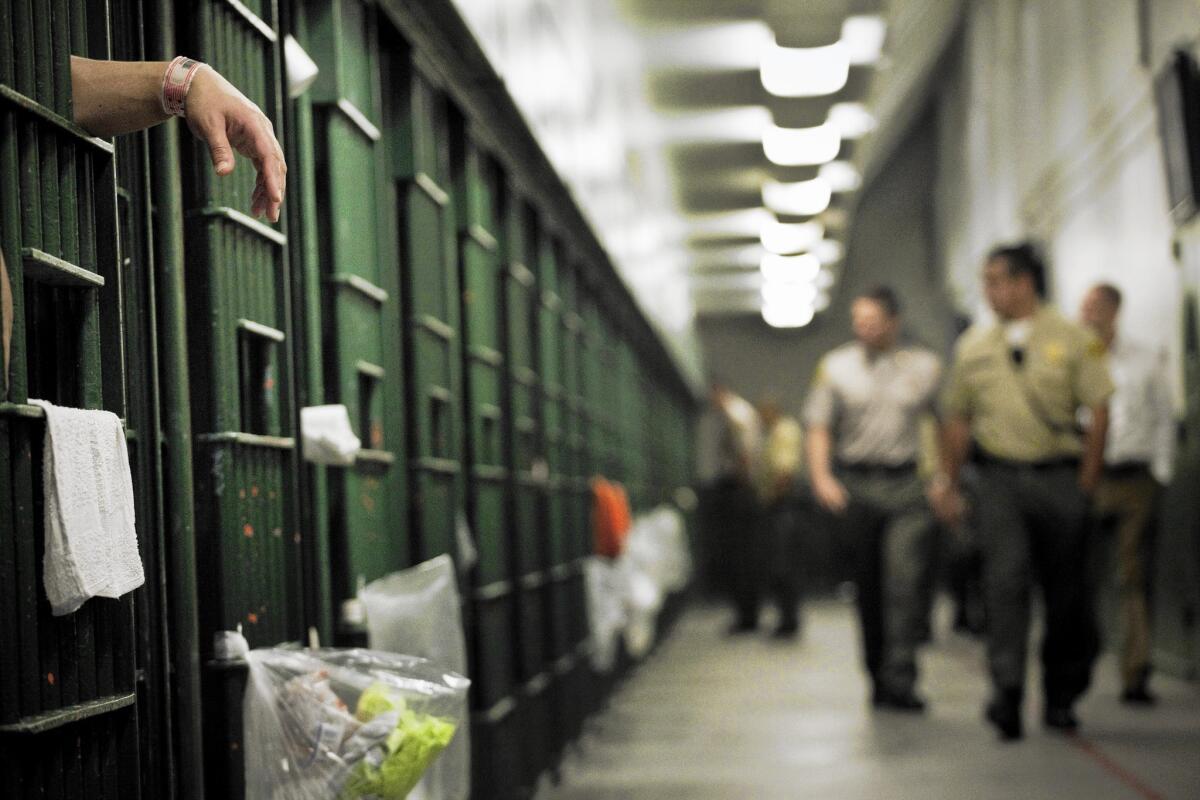L.A. County supervisors vote to move forward on $2-billion jail plan

- Share via
After years of debate about how to best modernize the county’s aging and troubled jail system, Los Angeles County supervisors voted Tuesday for a $2-billion plan to replace the deteriorating downtown Men’s Central Jail and create a new women’s jail.
They also voted to undertake an extensive study into how the county could divert more mentally ill offenders away from the jail system altogether.
Recent scandals and federal investigations into the mistreatment of inmates by their Sheriff’s Department jailers added urgency to Tuesday’s action, but supervisors — two of whom will soon be leaving office — remained divided over what to do about the jails and at what cost.
Under the plan, the county would tear down the system’s overcrowded downtown cornerstone and replace it with a new two-tower, 4,860-bed jail. It would be geared toward inmates with mental health issues but would also have beds for high-security inmates and those requiring drug and medical treatment.
The county would also replace the women’s jail in Lynwood with a 1,600 bed “campus-like” facility at the now-vacant Mira Loma Detention Center in Lancaster.
The plan will not significantly increase the number of beds in the overcrowded county jail system but is intended to help the jails comply with federal mandates on the treatment of mentally ill inmates.
Board Chairman Don Knabe said in a statement, “We have addressed the safety needs of both our staff and inmates, and developed plans to better manage our jail population by focusing on the need for comprehensive mental health and drug rehabilitation services.”
The proposal has drawn fire from several quarters. Advocates have criticized the board for hiring a construction firm to recommend how to handle the county’s jail population without looking for ways to divert mentally ill offenders from lockups.
The critics included several of the candidates running to be the next sheriff, who argued that the board should wait until a new top cop and two new county supervisors take office in December before making any decisions. Retired sheriff’s commander Bob Olmsted said the plan “doesn’t address the real issue” of dealing with the mentally ill. And Long Beach Police Chief Jim McDonnell said that although the jail needs to be replaced, “My fear is that we’re moving too quickly without including enough stakeholders and subject matter experts.”
Supervisor Gloria Molina, who will be termed-out in the fall, said deciding on a construction option is only the first step in a long process and that replacing the jail is “inevitable” for whoever takes office. “They’re going to have to replace the jail, whether they like it or not,” she said.
Molina, Michael D. Antonovich and Don Knabe voted in favor of the plan, with termed-out Supervisor Zev Yaroslavsky voting no and Mark Ridley-Thomas abstaining.
Yaroslavsky expressed concerns about the projected $1.98-billion construction price tag — an increase from projections last year that pegged the cost at about $1.3 billion — and added $213 million a year in operating expenses under the plan.
“All of us have been around long enough to know that if you’re telling us it’s $2 billion today, it’s not going to go down — it’s only going to go up,” he said.
Ridley-Thomas said that modernizing the jail system “is nothing short of a mandate for both moral and legal reasons” but that he did not think there had been enough study of how the county might divert more mentally ill inmates to treatment programs.
But other county officials argued that the federal government could soon intervene — as it has in the state prison system — if the county does not move quickly to improve conditions for mentally ill inmates.
“If we don’t act, the choice will not be ours, but up to a [court-appointed] receiver who will force us to act, at a much higher cost,” Antonovich said.
All five supervisors voted to undertake an analysis of diversion programs for mentally ill offenders in the county and the availability of beds in a non-jail setting to support that population.
A task force headed by Los Angeles County Dist. Atty. Jackie Lacey has already begun looking at the issue. Representatives of the National Alliance on Mental Illness, which is part of Lacey’s group, called on the board to hold off on picking a jail plan until they finish their work.
Lacey did not take a stand on the timing but told the supervisors she is optimistic that about 1,000 of the county’s approximately 3,000 mentally ill inmates could be diverted to non-jail beds, reducing jail crowding and costs.
“The use of jails as a surrogate mental health ward has resulted in extremely high costs,” she said. “The current system is, simply put, unjust.”
The board will next award contracts for design work and environmental studies, as well as developing a timeline and funding plan.
The city of Adelanto is also trying to woo the county to build a jail for sentenced inmates in that High Desert community, arguing that it would reduce the number of beds needed to be built downtown. A spokesman for Antonovich said he thought the possibility “should be considered in discussions regarding future contracting options,” and Molina said it could be an option to increase the number of jail beds and prevent early release of prisoners, but the board has not formally discussed the proposal.
More to Read
Sign up for Essential California
The most important California stories and recommendations in your inbox every morning.
You may occasionally receive promotional content from the Los Angeles Times.











